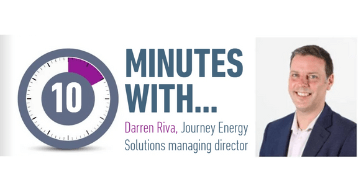As car retailers across the UK look to combat soaring energy prices with the installation of renewable solutions, AM interviewed Journey Energy Solutions managing director Darren Riva.
In this, the latest of our '10 minutes with...' feature series, Riva explains how the benefits extend beyond financial savings and why businesses should act fast to impliment their emissions-cutting plans.
How did Journey Energy Solutions come into being?
Journey Energy Solutions has been around for a couple of years now and I have been in the energy sector for 12-to13 years. Capitas Finance is the finance part of the business, but the two businesses are entirely separate legal entities. My background has been in finance, helping to fund energy projects or working with suppliers in the sector to provide energy-efficient or renewable technology. We started Journey because we saw there was a big gap in the supplier and installation market for someone that could provide a holistic view to help a customer to see and address their energy usage and requirements. All that is done in a service-type contract so the customer can be confident that the technology is maintained throughout.
What proportion of business is in the automotive retail sector?
Probably about 20%. There are 25-to-30 car retail groups that we are working with currently and we have a lot of opportunities that we’re working on at the moment.
What are businesses’ priorities when they approach Journey Energy Solutions?
In the past the main priority has always been ‘how can we save money?’ and, thanks to the model that Journey operates, the reality is that the projects are always cash positive from day one. More recently there has been a focus on carbon reduction, particularly from the larger corporates. In the past four or five months, though, it’s shifted very much back into the arena of saving money again, even though the carbon piece remainsmore important than ever before.
How does Journey set about helping a business reduce its energy costs and carbon footprint?
We try to understand what their energy usage is. Data from the customer gives us a good view before we even visit a site. It may be that they have come to us to implement a specific technology, such as low-energy lighting, in which case we can carry out projects at a couple of sites and show the benefits. After that, it’s quite common that businesses come back to us to ask if we can look at implementing solar or battery storage. Lowenergy lighting is generally the quickest payback, but we can provide most renewable and sustainable technologies. Solar has come back very strongly recently. We can do things like heat pumps, but the heating piece is trickier in the medium-to-long term because there is a big push by the Government right now to electrify heat. It’s also not as simple as swapping out a gas boiler with a heat pump. We have to change a lot of the infrastructure of the building.
Is it difficult to secure funding for green energy solutions?
Because of Capitas’ ability to provide longer-term contracts, the finance is less of an issue. The biggest issue is taking that first step. It’s almost too much of a no brainer for many businesses to believe. It can seem too good to be true. Because the solutions are electricity-based, though, you’re able to see the results from day one.
How has the energy crisis affected return on investment?
Sites that would have been 5%-to-10% cash positive in year one are now getting 30%-to-35% savings in year one. We have been consistent in the terms which we provide; the big difference has been the cost of energy. It’s also the main reason that solar is coming back. I’ve worked with solar for more than 12 years – right through the whole feedback tariff period – and the payback has always been eightto-10 years. Now we’ve seen that reduce to around five years. The flip side is that you’re now getting seven-and-a-half to 10 pence per kilowatt hour to feed backenergy into the grid. At the moment, with energy prices what they are, you don’t want to feed back into the grid because you’d essentially be ‘putting it back’ at a much cheaper rate. So, we’re being very careful to right-size our solar projects.
If you want to generate your own electricity on site, what are the best solutions?
Solar’s a relatively simple technology and it doesn’t get in the way of the operational business or require any planning permission. That’s in contrast to turbines. They are very effective but not many places have them because of the planning issues. Most local authorities have stopped approving turbines altogether.
What is the typical length of a contract with Journey?
A contract for lighting is generally six years. Solar might be longer, eight-to-10 years. Hire purchase could be 10-to-15 years for solar. What’s important, though, is that we are able to create a cash positive position from day one.
Does Journey provide the end-to-end energy solutions ‘in-house’?
We manage everything in-house. We have a couple of sub-contractors, but we do all the surveying, the specifications and the designs of the projects. If we’re asked to deal with a new technology that we’re not used to, we would bring in a supplier that is known to Capitas. The key thing is the quality of the product and the installation because, at the end of the day, we are liable for its performance for the duration of the contract.
What changes have been brought about by the shifting energy market over the past 12 months?
Since COVID we have seen a significant rise in the number of leads coming to us and since the energy price rises over the past six months it has gone through the roof. From our point-of-view it has all been about scaling up, ensuring our processes are as efficient as they can be and getting new people on board. Over the past quarter we have probably been processing 200% more leads than we were a year ago. We are going to be moving into new offices in Q4 this year and the plan is that we will be near Gerrards Cross. Currently, there are six of us in the Journey team and we have another team member joining shortly. I hope to have another two new recruits by the end of the year. We’re looking at doubling our volume of business every year and that’s just organic growth. Some of the deals we have are for lots of sites, one being for 600 buildings. I’d much rather this situation to where we were two years ago. I expect us to only getbusier and busier and it’s a great feeling. At the end of the day, yes we are helpin to manage costs for businesses butwe’re also reducing carbon for both the business and the UK. It’s a call to arms with benefits.
Has the shift to electric vehicles (EVs) altered car retailers’ view of sustainable energy?
Power becomes a critical part of that journey. You’re having to understand what type of power you need to get into your site, which chargers you need, all while looking ahead two-to-three years. The transition to EV is tough and it’s not one size-fits-all. I think the sector needs to seriously think about how it’s dealing withcharging. You would never go to the petrol station and fill a car with fuel as part of a service. The options would be giving the car back with the same amount in it as it was left with and, perhaps, charging a certain rate per kWh to charge it up beyond that point.
Will we see energy prices stabilise or reduce?
I think there are more increases to come. At the moment the big piece in energy costs is the wholesale price. Historically, you’d look at a bill and it would be made up of wholesale costs, distribution costs and green levies, roughly in three equal parts. That wholesale chunk has increased significantly. That should start to calm down, but that’s probably atleast 24 months away. At that point I expect the distribution element will increase because what the world is trying to do is create energy security. That means we need to generate more power here in the UK. In reality, energy costs have been too low for quite some time, and we’ve seen that borne out with so many providers going to the wall.
Have supply shortages impacted Journey’s ability to meet demand?
At the moment battery storage has been very hard hit, particularly due to the shortages of Lithium, which have seen prices go through the roof. Other things, such as lighting, have been impacted by Brexit and COVID but are starting to get back to something like normality. We have been able to source solar panels, but I think that’s going to get much tougher because the energy crisis is a global problem and demand is soaring. In terms of lead times, we can fulfil a lighting order in four weeks. For solar the difficulty is connection to the grid and that can take 12-to-16 weeks. Battery storage is really struggling. Some battery orders can take 12-to-18 months.



















Login to comment
Comments
No comments have been made yet.